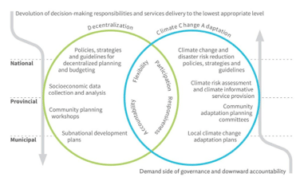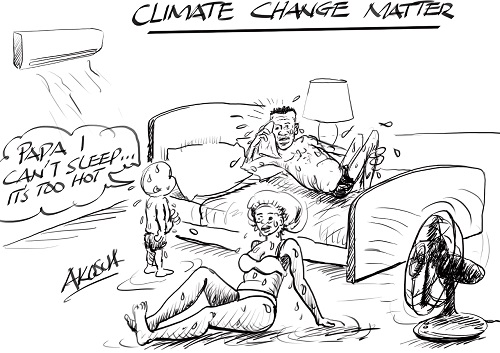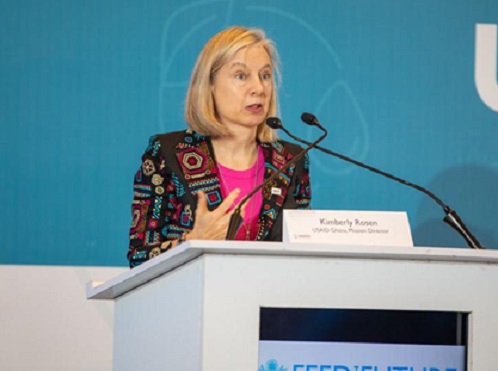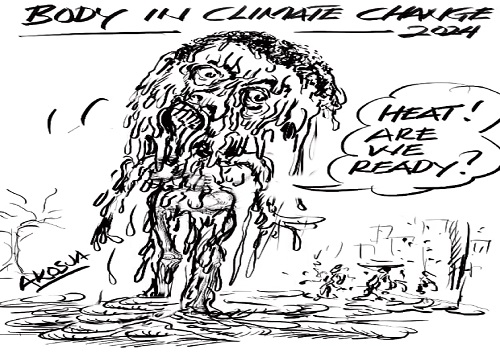
By Ebenezer ASUMANG
“I’ve starred in a lot of science fiction movies and, let me tell you something, climate change is not science fiction. This is a battle in the real world, it is impacting us right now”
———- Arnold Schwarzenegger, Actor & Former Governor of California

The global community’s investment in climate adaptation is woefully inadequate. Only USD 30 billion is spent annually, representing 10% of the projected USD 387 billion required annually (UNEP, 2020). Furthermore, only a limited proportion of this funding reaches developing countries and finances locally led initiatives (OECD, 2020). This is concerning, as community-based adaptation is crucial for effective climate adaptation.
Why community-based adaptation?
Community-based approaches to adaptation give local people and communities decision-making power in adapting to the effects of climate change and the resources, agency, and support they need to make sound investments in climate adaptation measures.
Still, most adaptation remains top-down, led by entities like donors, large intermediaries, and central governments. A recent World Resources Institute (WRI) analysis of community-centered interventions found that only about 6% of 374 projects and programmes reviewed featured locally led elements, such as local decision-making power.
Community-based adaptation is essential because the most effective adaptation measures are those tailored to local needs and executed at the grassroots level (Ayers & Huq, 2009). This localised approach not only addresses the immediacy of climate change impacts but also ensures that strategies resonate with the community’s lived experiences (Adger et al., 2005). For instance, a study in Bangladesh found that community-led adaptation initiatives were more effective in reducing vulnerability to climate-related disasters than top-down approaches (Huq & Ayers, 2008).
Barriers to community-based adaptation
Despite the importance of Community-based adaptation, several barriers can hinder progress, including ecological and physical constraints, limitations in knowledge and resources, and social dynamics (Barnett & Adger, 2007). For example, a study in Africa found that limited access to finance and technology was a significant barrier to Community-based adaptation (Mertz et al., 2012).
Strategies to boost funding for community-based adaptation
Coger et al., 2021 note three high-level strategies to increase funding for community-based adaptation:
Implement climate budget tagging:
This tool should be used to pinpoint investments relevant to climate concerns. Governments should enhance current budget tagging methods and integrate tracking for community-based adaptation finance. This can be achieved using specific codes or weights that align with carefully defined quality metrics.
Conduct expenditure reviews:
When expenditure reviews tag budgets, they focus on current budgets and analyze past spending. As many governments already employ various public expenditure reviews to blend climate finance into their plans, a similar approach can help trace finance allocated for locally-led adaptation. Previous efforts to use this approach offer important lessons (UNDP, 2015).
Use established policy and planning measures:
Many nations already report country-level adaptation finance, which presents chances to include tracking for locally-led adaptation finance. Relevant activities might encompass surveys of regional climate actions, the National Adaptation Planning process, and the UNFCCC’s biennial finance overview.
The potential of devolved finance
Devolved climate finance, also called decentralized finance, can help address climate change at the local level in the following ways:
- Reach the most vulnerable: Devolved climate finance can help reach communities that need it most, so they can prioritize it to deliver solutions on the ground
- Integrate concerns around climate change adaptation: Devolved climate finance can integrate concerns around climate change adaptation into decentralized governance and administrative frameworks to scale up local adaptation measures
- Build an inclusive and sustainable local financing mechanism: The Decentralised Climate Funds project in Mali and Senegal builds an inclusive and sustainable local financing mechanism that encourages decentralized allocation of climate funds at the local level.
- Provide additional funding: Devolved climate finance can provide additional funding to help local communities adapt to climate change beyond existing development finance mechanisms.
- Redirect investment flows: Devolved climate finance can redirect investment flows from high-carbon projects toward climate-friendly opportunities and incentivize low-carbon investments.

Source: Ziervogel et al. 2019
The Devolved Climate Finance (DCF) Alliance presents a pioneering framework to channel investments into local public amenities and establish the right conditions for sustainable development. DCF operates on five foundational principles and seeks to address governance and climate challenges: Community-led planning; support for existing institutions; social inclusion; adaptive management and public goods focus.
The role of the private sector
International and national public sector funds alone will fail to provide the enormous sums of money required to support adaptation and build resilience among vulnerable communities across the globe. For example, the African Development Bank notes that “to close Africa’s climate financing gap by 2030, approximately USD 213.4 billion will need to be mobilized annually from the private sector to complement constrained public resources.” Currently, most current climate financing in Africa is from public actors (87%, USD 20 billion) with limited finance from private players.
Blended finance, which combines public and private sector investments, offers a promising avenue to reduce risk and the weighted cost of capital, and to leverage capital to catalyze innovation and market transformation, at scale.
The public sector, which includes national governments and multilateral development banks, such as the European Investment Bank, can offer initial risk protection through investments, equity capital, or improved credit conditions. If development partners and multilateral banks focus on equity rather than debt, they can prevent increasing the debt load of developing nations.
While public finance is smaller in scale, it remains vital since policymakers can directly control it, and it funds public goods and services that the private sector may not support. When used correctly, public finance can boost private investment as it can promote markets, drive innovation, and minimize risk
Conclusion
Climate change community-based adaptation financing is crucial for supporting vulnerable communities in adapting to the impacts of climate change (UNFCCC, 2015). While international and national public sector funds play a vital role, they are insufficient to meet the enormous funding needs (OECD, 2017). Blended finance, which combines public and private sector investments, offers a promising solution to leverage capital, reduce risk, and catalyze innovation (World Bank, 2018)
Credit:
UNEP (2020). Adaptation Gap Report 2020.
World Bank (2018). Blended Finance: A Primer for Policymakers. World Bank Group.
OECD (2017). Climate Finance in 2016. Organisation for Economic Co-operation and Development.
OECD (2017). Climate Finance in 2016. Organisation for Economic Co-operation and Development.
UNFCCC (2015). The Paris Agreement. United Nations Framework Convention on Climate Change.
UNDP (2013). Climate Change Adaptation in Africa: UNDP Support to Enhance Adaptation Capacity.
UNFCCC (2011). Report of the Conference of the Parties on its sixteenth session, held in Cancun from 29 November to 10 December 2010. Part two: Action taken by the Conference of the Parties.
World Bank (2010). World Development Report 2010: Development and Climate Change.
Tschakert, P., & Dietrich, K. (2010). Anticipatory learning for climate change adaptation and resilience. Ecology and Society, 15(2), 11.
Ayers, J., & Huq, S. (2009). Supporting adaptation in developing countries: What role for official development assistance? Climate and Development, 1(1), 1-13.
OECD (2020). Climate Finance Provided and Mobilised by Developed Countries in 2019.
Agrawal, A., & Perrin, N. (2008). Climate change, local institutions, and adaptation in rural India. Climate Change, 98(1), 107-126.
About the Writer
Ebenezer is a PhD, Media & Communication student specialising in Development Communication. His research interests include climate change adaptation and climate action, environmental and participatory communication, development journalism, communication for social change, community radio, and green finance.
Connect with him via: [email protected] / [email protected]
LinkedIn: Ebenezer Asumang. [ https://www.linkedin.com/in/ebenezer-asumang/ ]
The post The Climate Change adaptation discourse: Financing community-based initiatives appeared first on The Business & Financial Times.
Read Full Story









Facebook
Twitter
Pinterest
Instagram
Google+
YouTube
LinkedIn
RSS